#High-yield crop varieties
Explore tagged Tumblr posts
Text
How Big Should Your Farm Be to Make a Profit?
Many new agripreneurs believe that the size of their farm will determine how profitable they’ll be. However, you can be profitable whether you’re farming 1 hectare or 100 hectares; it all depends on how you farm. When it comes to land, the most important thing to consider is not the number of hectares at your disposal, but rather the commodity that you farm and how you manage and control costs.…
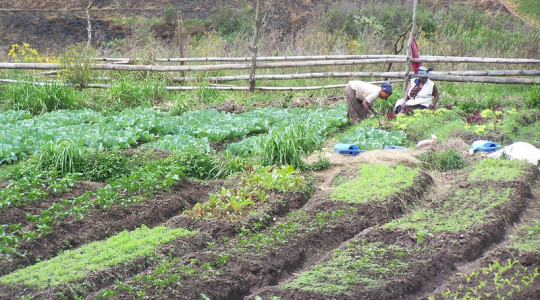
View On WordPress
#Agricultural business success#Crop diversification benefits#diversified farming#Effective irrigation systems#Efficient farming methods#Farm cost management#Farm operational costs#Farm planning strategies#Farm productivity tips#farm profitability#Farm risk management#Farming market trends#Farming technology#high-value crops#High-yield crop varieties#Large-scale farming#Livestock integration#Low-cost farming solutions#Micro-farming#Modern farming tools#Niche crop farming#Organic farming practices#precision farming#Profitability in agriculture#Small farm equipment#Small-Scale Farming#Smart farming techniques#Starting a farm business#Successful farming examples.#sustainable farming
1 note
·
View note
Text
गन्ने की खेती में क्रांति: नई किस्म को.लख. 16202 से होगा बंपर उत्पादन
लखनऊ: गन्ने की खेती करने वाले किसानों के लिए बड़ी खुशखबरी है। अगर आप गन्ने की बुवाई की योजना बना रहे हैं, तो भारतीय गन्ना अनुसंधान संस्थान, लखनऊ के वैज्ञानिकों द्वारा विकसित नई किस्म को.लख. 16202 को जरूर आजमाएं। यह किस्म गन्ने की खेती में न केवल बंपर उत्पादन देगी, बल्कि कम लागत और रोग प्रतिरोधक क्षमता के कारण किसानों को बेहतर मुनाफा दिलाएगी। को.लख. 16202: नई किस्म की खासियत गन्ने की इस नई किस्म…
#High Yield Sugarcane Varieties#improved variety of sugarcane#Indian Sugarcane Research Institute Lucknow#Kheti Kisani Hindi News#Kheti Kisani News in Hindi#New Sugarcane Variety Co.Lkh 16202#new variety of sugarcane#sugar#sugar meal#Sugarcane#sugarcane crop#sugarcane cultivation#Sugarcane Farming in India#Sugarcane Farming Tips#sugarcane production
0 notes
Text

Biodiversity loss in agriculture is a pressing threat to global food systems, reducing our ability to cope with climate change, environmental degradation, and nutritional challenges. Over the past century, about 75% of plant genetic diversity has been lost as farmers have shifted toward high-yielding, genetically uniform crops. Today, just nine plant species account for 66% of global crop production, with rice, wheat, and maize alone providing more than 50% of the world’s plant-derived calories. This reliance on a narrow set of crops undermines food system resilience, leaving us vulnerable to pests, diseases, and climate extremes. It has also created a monocultural vulnerability reminiscent of the Irish potato famine of the 1840s, when reliance on a single, genetically uniform crop led to catastrophic losses due to disease. Genetic diversity within and among species acts as a natural buffer against environmental changes. Different crop varieties respond differently to stressors, providing farmers with options to manage risks. When one crop fails, others can compensate, helping to safeguard harvests and livelihoods. However, as the diversity on our farms diminishes, farmers have fewer tools to adapt to the growing volatility brought on by climate change. Extreme weather events such as droughts, floods, and heat waves are becoming more severe, and monocultures are ill-equipped to withstand these shocks. The environmental impact of current agricultural practices further exacerbates biodiversity loss. Agriculture is responsible for about 90% of global deforestation and contributes substantially to habitat destruction, driving the extinction of countless species. Excessive use of inorganic fertilizers and pesticides pollutes soils and waterways, disrupting ecosystems and degrading essential natural services such as pollination and soil fertility. Soil degradation now affects one-third of the world’s soils. In sub-Saharan Africa, agriculture is responsible for 80% of soil degradation on farmland, leading to reduced plant diversity because only the few species that can tolerate poor soil conditions survive. Moreover, the heavy use of nitrogen fertilizers and livestock manure, particularly in regions such as Asia and Latin America, has disrupted natural nitrogen cycles, contributing to greenhouse gas emissions such as nitrous oxide and methane. These emissions not only drive climate change but also accelerate biodiversity loss by reducing the resilience and health of ecosystems. The decline of agricultural biodiversity also impacts human health. Diets worldwide have become increasingly homogeneous, dominated by a few staple crops that are energy-rich but nutrient-poor. Less than 200 species currently contribute to global food supplies, and this lack of variety has serious health consequences. Low dietary diversity is now a leading driver of diet-related deaths, with about 11 million premature deaths annually linked to unhealthy diets. The decline in biodiversity means that fewer nutrient-rich foods such as fruits, vegetables, nuts, and seeds are available, exacerbating malnutrition in all its forms, from undernutrition to obesity.
10 October 2024
63 notes
·
View notes
Text
There are more than 1,000 varieties of banana, and we eat one of them. Here’s why that’s absurd...
The lack of diversity could mean the fruit’s extinction. It offers a stark warning of what could happen to other key foods.
Most people don’t question why every banana they’ve ever eaten looks and tastes pretty much the same. Most of us will never try a blue java from Indonesia with its soft, unctuous texture and flavour of vanilla ice-cream, or the Chinese banana that is so aromatic it’s been given the name go san heong, meaning “you can smell it from the next mountain”. The demand for low-cost, high-yielding varieties has resulted in vast monocultures of just one type of globally traded banana, and this is true of many other crops as well. Homogeneity in the food system is a risky strategy, because it reduces our ability to adapt in a rapidly changing world...
Read more: https://www.theguardian.com/commentisfree/2024/mar/22/1000-varieties-banana-lack-of-diversity-extinction
143 notes
·
View notes
Text

The Forbidden Garden of Leningrad by Simon Parkin
This fascinating history of Nikolai Vavilov and the staff at his plant institute tells a story of almost unbelievable self-sacrifice while under siege during the second world war
Is there any human endeavour as heroic or under-appreciated as plant collecting? When in 1921, at the age of 33, Nikolai Vavilov arrived in Petrograd (now St Petersburg) to take charge of the bureau of applied botany and plant breeding, he found a city racked by hunger. War followed by civil conflict had crippled Russia’s food production and distribution systems – a situation compounded by the seizure of peasants’ grain stores by the Bolsheviks – and Petrograd, once the cradle of the Russian empire, had been transformed into a graveyard. Walking along Nevsky Prospekt, Vavilov was appalled to see starving citizens queueing for mouldy bread. “Westward the sun is dropping,” observed the poet Anna Akhmatova, “and already death is chalking the doors with crosses.”
On entering the bureau, Vavilov was even more dismayed to find the heating pipes had burst and the storage units containing nearly 14,000 varieties of wheat, barley, oat and rye collected by his predecessor had been eaten by famished staff. It was, recorded a member of Vavilov’s team, “a picture of almost complete destruction”.
Yet by 1940, Vavilov had secured new premises in a former tsarist palace in the centre of the city and had amassed the largest collection of seeds in the world. It was a collection brimming with “latent life”, writes Simon Parkin in his riveting account of Vavilov’s plant institute, “a Noah’s Ark of plant matter”. Once cultivated and harvested, the seeds contained sufficient genetic material to feed not only the citizens of Leningrad, as the city had been renamed following Lenin’s death in 1924, but the entire population of the Soviet Union. In the process, Vavilov, a tireless polyglot, would become the most celebrated botanist in the world, feted by scientists from Edinburgh to New York. All the more extraordinary, then, that today he is all but forgotten, a victim of the Soviet state’s desire to erase memories of the siege and the millions who perished in the Nazi onslaught.

Karl Marx wrote that “history repeats itself, first as tragedy, second as farce”. The tragedy is that having amassed a collection with the potential to banish famine, Vavilov was arrested on the eve of war and branded “an enemy of the people”. In this, he appears to have been a victim of a bitter struggle with the peasant-agronomist Trofim Lysenko, who had rejected Mendelian genetics for Lamarckism – the idea that plants and other organisms acquire superior traits from their environments rather than from inherited genetic material. Lysenko believed that through a combination of agronomical knowhow and political will, these traits could be passed down to future generations – a theory that Stalin found appealing.
The result was that when in July 1941, the Soviet authorities began fortifying Leningrad in preparation for the German siege and evacuated precious artworks from the Hermitage, Vavilov’s collection was ignored, though whether this was deliberate or a bureaucratic oversight, Parkin cannot say. What he shows, brilliantly, is how the farce of the seeds’ non-evacuation nearly ended in a second tragedy as Vavilov’s colleagues fought to preserve the collection from raids by starving citizens and their own gnawing hunger. Incredibly, of the 250,000 seeds that Vavilov had amassed at the outbreak of war, the majority survived and by 1967, 100m acres of Russian agricultural land had been planted with material from the institute’s collection. Not only that, but wheat collected by Vavilov in Spain, Japan, Italy and Argentina was crossbred to create high-yielding winter varieties, while potatoes from Bolivia were used to breed hybrids resistant to disease. Today, 90% of the seeds and planted crops in the institute’s collection are found in no other in the world.
Writing in 1737, Carl Linnaeus, the father of modern taxonomy, observed: “When I consider the melancholy fate of so many of botany’s votaries, I am tempted to ask whether men are in their right mind who so desperately risk life and everything else through the love of collecting’ plants.” Imprisoned for the duration of the war, Vavilov would never return to his beloved institute and died of hunger in 1943 at a prison in western Russia. Afterwards, ashamed of their persecution of the world-renowned botanist, the authorities destroyed Vavilov’s case file and did their best to discourage journalists from writing about his achievements. The result was that it was not until the late 1970s that Vavilov’s story and the fate of his employees became more widely known. Even so, Parkin’s is the first book to have been published on the subject outside Russia.
To recreate the story, the author has drawn on the institute’s archives and the diaries and letters of the two-dozen staff to whom it fell to guard the collection during the near-900-day siege, one of the longest of any city in history. In the process, he restores Vavilov and his scientific colleagues to their rightful places in the pantheon of Soviet heroes. But perhaps Parkin’s biggest achievement is to explain how the botanists who sat out the siege resisted the temptation to consume the collection. Instead, he details how they defended the seed bank from looters and braved German bombs to plant potatoes at a field station on the perimeter of the city, thereby ensuring they would produce new tubers that could be stored and preserved for the following year.
In the process, 19 staff died, most of them of starvation while surrounded by containers that could have saved their lives. In this they were guided by the conviction that many of the samples were irreplaceable because of the loss of natural habitats from which they had been collected and that they could contain unrecognised genetic qualities. Their resolve was also a product of their loyalty to Vavilov and their belief in the importance of the scientific endeavour. As one survivor told Parkin: “It was impossible to eat [the collection], for what was involved was the cause of your life, the cause of your comrades’ lives.” Astonishingly, this resolve held despite an explicit order from Moscow to “spare nothing” to save the lives of their fellow citizens.
Although Parkin has done a remarkable job of resurrecting the story of this “forbidden garden”, he admits to frustration that his efforts “could not transport me to the white-hot centre of the story”. It is a frustration this reader shares. Despite a wealth of information about the siege, the thoughts, feelings and cravings of Vavilov’s staff remain tantalisingly out of reach. Instead, Parkin ends on a deflationary note, admitting he has no answer to the question of whether in opting to sacrifice the lives of people in the present for the benefit of future generations, the botanists made the correct moral choice.
Daily inspiration. Discover more photos at Just for Books…?
11 notes
·
View notes
Text
Winter Squash for Tight Quarters
Compact varieties save space without sacrificing flavor
11 notes
·
View notes
Text
Day 9: Shell
It was something straight out of a storybook, to see their efforts actually work.
Reports have come through daily, compiled from sections of industrial plants, mines, and -most importantly- the agricultural industry.
It wasn’t that it didn’t exist before, per say, but the limitations of living on and near an active volcano have essentially funded projects and ‘solutions’ via war confiscations.
But with The Plan?
It opened up occupations ranging from greenhouse manufacturing, pipe construction, electronics manufacturing (in which he’s heard that Iggy collaborated with budding inventors for), and the overall selection process for what Luigi knew as ‘High-Yielding Variety’ crops.
It doesn’t hurt that diplomatic negotiations have also opened up trade.
Unemployment rates dropped to 13% by the second day -AND the only reason it wasn’t lower was due to the process of training the kingdom’s workforce for what is essentially new production procedures.
He would have gone to see the training himself, maybe even suggested ways to streamline it, but…
Since he apparently couldn’t be trusted to keep himself safe, Bowser and his brother have come to a rare agreement:
Luigi, Ambassador of the Mushroom Kingdom, Ghost Hunter, Thrice Defeater of King Boo, and one of the Mario Brothers… is now to be babysat by the Koopa King.
In the first two days in Bowser’s possession, Luigi had only been let down when he had either needed to go to the bathroom, or if his brother and Peach were visiting.
Not even the presence of snickering diplomats deterred him.
Bowser’s plastron (unless they call it something different…?) was surprisingly velvety to the touch, although experimental pokes showed it to be just as hard as his shell.
And no, he was NOT feeling the Koopa up! That would’ve been rude!… But boredom was universal for those of the confined, and Luigi was adamant about not staring at Bowser’s face OR falling asleep!
Hence, his investigations.
“Something on my face?”
And just like that, Luigi is snapped from his reverie -blushing when he realizes he’s been staring at Bowser’s face.
'Luigi, you fool! You thoughtless fool!'
He’s internally screaming, but the Koopa only shows amusement as Luigi burrows into his green sweater.
“I know I’m a handsome Koopa, but you don’t have to stare~.”
Luigi could only whine.
With a snort, he taps Luigi’s hat over his eyes “Really, though. What’s got your head in the clouds?”
Righting his hat -really, the nerve of this guy- Luigi shoots him a half-hearted glare. “N-nothing!”
“Oh?” Bowser obviously doesn’t believe him. “My devastatingly gorgeous looks are nothing to you?”
“No! I mean-“ Luigi knows that his face is as red as his brother’s hat, but that’s the least of his worries. “Stop twisting my words!”
Bowser bursts into guffaws that have Luigi bounce on his plastron, having the mind to have a paw out to prevent the human from bouncing out of his grasp.
“A-and 'no-thing' m-eans-s noth-ing!”
The guffaws eventually abate, but the crap-eating grin Bowser wore was nearly unbearable. "And your expression means that it's not 'nothing'! So cough it out!"
Bowser was enjoying the way Luigi seemed to get more and more flustered, noting the way his blush spreads from his cheeks, to his ears, and then down to his neck. It almost makes him curious to see-
Ahem.
He focuses back on the Green Bean, realizing that he resorted to burrowing his face into his plastron. He could barely feel the pressure from it- almost like having a bowl of grapes rest on him.
"Would you rather have Mario to talk to? I'm sure he has some spare time-"
"NO!"
He jolts in his seat, not expecting the shy human to actually shout.
...It's almost impressive, for him to have those kind of pipes.
"sorry." Bowser barely hears it, but it's enough to lead him back to the topic.
"Then let it out Greenie. It's not like I get offended easily."
Luigi mutters something that almost sounds passive-aggressive, but he isn't given time to guess before Luigi blurts out:
"What do you call it?"
He's.... stumped. "It?"
"Um." The blush is back, but the human seems determined to elaborate. "The hard thing on your stomach. What is it called?"
Bowser smirks, but simply replies, "A plastron."
This time, he KNOWS he hears a 'knew it' from Luigi, and Bowser's smirk is slowly growing wider.
"And-and those?" The man touches the tips of his fingers, gesturing at the sharp edges. "Do you call them claws -or talons, or...?"
"Claws." Bowser resembles a particularly toothy alligator now. "I was joking about the staring, but I didn't realize I'm so fascinating to you."
"You are!"
And now he's sure he looks shocked stupid.
"N-NOT LIKE THAT! I mEAN-" Luigi is panicking, clearly. "I- just wanted to know because I wasn't sure? I- never really saw a Koopa outside battle, and- and you guys look really interesting!"
He is so, utterly glad that Koopas can't blush.
Still, he does his best to look nonchalant. "Well- why didn't you say so? The Royal Library has a bunch of books about our impressive anatomy! I can 'supervise' while you read your tiny heart out!"
"...YOU HAVE A LIBRARY?! AND YOU DIDN'T TELL ME?!"
THAT is only answered with a laugh as Bowser starts to lumber down a hall, not caring as the human starts to sputter.
Honestly? He's glad to have Luigi as a friend. But the human?
He's adorable ridiculous.
#bowuigi#KAIJUNE Prompt#short#but honestly a breather as things get heavier#til next post!#HAPPY PRIDE MONTH
93 notes
·
View notes
Text
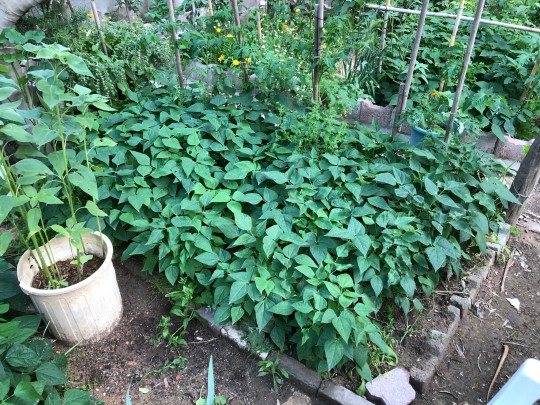
Dragon Tongue beans are a great bush bean variety to grow, these kind of beans are high yield crops.
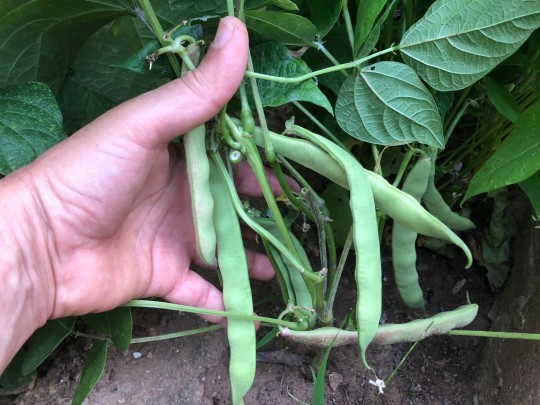
To grow Dragon Tongue beans successfully, bean plants should have evenly moist soil at all times. Water lightly at planting, medium at flowering, and heavily throughout harvest time!

Read More: How To Grow Dragon Tongue Beans
#lovegardening#gyo#gardening uk#gardenchat#organic gardening#vegetable gardening#gardening#garden#gardening tips#backyard#gardens#gardenblr#gardencore#gardeners on tumblr#home and garden#my garden#botanical garden#potted garden#urban gardening#vegetable garden#plants#vegetablegarden#vegetables#veggiepatch#growyourown#organicgardening#homegrown#greenthumb#mygarden#backyardgarden
78 notes
·
View notes
Note
https://www.tumblr.com/mochinomnoms/750399534369275905/your-talk-about-museums-and-ancient-artifacts
No no, please, do tell about the agriculture of Mexico! They made islands for agriculture?? What type of products grew on them? How did they work??
Do you have any recommendations of sites or works to see more of it?
Also you should see the type of economy Incas had, like, they didn’t have a writing system; which is why keeping languages like Quechua really complicated, and their economy was more family based? It’s kinda complicated to explain for me but it’s more akin to trading than anything modern in my opinion.
Chinampas! They're very cool and a super ingenious method of agriculture that doesn't affect the rainforest around them but utilizes the lakes! I'll be using this and this as my main source to reference.

"Chinampa system is an historical system adapted to face hydrologic and climatic constraints and the pressure by the high city’s food demand. The chinampa farmers have been able to handle certain balance between the sustained yield and the environmental and technological management factors. This ecosystem performance has been based on the biological stability improvement, including sophisticated farming methods such as multiple cropping and shift of crops."
As you can see, they're man-made and developed by the Mexica (Aztecs) in the 14th century in the lakes of Xochimilco and Chalco, which surround Lake Texcoco, the lake that Mexico City takes residence in.

They're best described as ���floating gardens” and due to the nutrient rich materials used to built them, are very fertile and can grow a great variety of crops. This of course includes Mexico's staple crop of maiz, but also beans, squash, tomatoes, chili peppers, and even flowers. The chinampas system provides a built-in natural irrigation system, and were home to aquatic wildlife and birds. This benefits the system further, as these animals increase the fertility and nutrients in the water and soil. There was also a drainage system, which facilitated the movement of water and sediments!
There were some cultural practices in association with chinampas, but they're best associated with the sort of 'urbanization' that Tenochtitlan was going under as the Mexica grew.
There have been much more recent studies done on the chinampas system, as modern agriculture as we know it is highly unsustainable due to lack of land and the general environmental concerns around agriculture. Utilizing chinampas in modern agricultural system has several benefits which include space efficiency, biodiversity, sustainable water management, carbon sesquention (migating climate change), and community engagement.
The last is particularly important, as it involves local communities in food production and builds on the concept of 'third-spaces' for people. Third spaces are typically places that individuals can spend time with their communities without the need to spend money for services or products. Libraries are the best example of this, but there have been others that have been lost over time.
This is not to say that chinampas don't exist anymore! They very much due primarily in San Gregorio, Xochimilco, Mexico City. THere are also some in San Luis, Tiahuac, and Mixiquic.

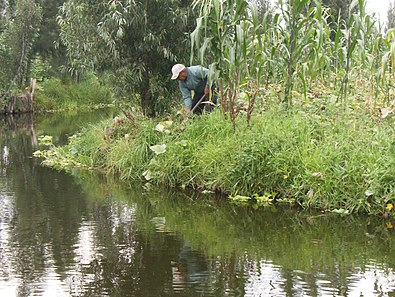
Other countries around the world have been inspired by chinampas, such as the Floating Gardens of Bangladesh, the Green Float project in Osaka Bay, Japan, and the Urban Rivers project in Chicago, USA.
There are some difficulties in maintaining current chinampas and bringing them back, as many of the original lakes were drained by the Spanish which reduced their ability to support agriculture. Earthquakes have also damaged them and the canals, as well as the scarcity of fresh water, pesticides, climate change, urban development, and water pollution.
I've gone on a bit long now, but I am familiar with the Inca and Quechua communication system you are referring to! It's a system based on knots if I'm not mistaken! I might be inclined to go into that in a future date!
#mochi asks#professor mochi#chinampas my beloved#nowadays theyre a popular tourist attraction#i think ryan and shane even went to a haunted one during buzzfeed unsolved
13 notes
·
View notes
Text


Biotechnology and the future of humanity
The End Of Diversity
GM technology is also set to plunge countless thousands of people into poverty by using GM plants or tissue cultures to produce certain products which have up until now only been available from agricultural sources in the majority world. For example, lauric acid is widely used in soap and cosmetics and has always been derived from coconuts. Now oilseed rape has been genetically modified to produce it and Proctor & Gamble, one of the largest buyers of lauric acid, have opted for the GM source. This is bound to have a negative effect on the 21 million people employed in the coconut trade in the Philippines and the 10 million people in Kerala, India, who are dependent on coconuts for their livelihood. Millions of smallscale cocoa farmers in West Africa are now under threat from the development of GM cocoa butter substitutes. In Madagascar some 70,000 vanilla farmers face ruin because vanilla can now be produced from GM tissue cultures. Great isn’t it? 70,000 farming families will be bankrupted and thrown off the land and instead we’ll have half a dozen factories full of some horrible biotech gloop employing a couple of hundred people. And what will happen to those 70,000 families? Well, the corporations could buy up the land and employ 10% of them growing GM cotton or tobacco or some such crap and the rest can go rot in some shantytown. This is what the corporations call ‘feeding the world’.
Poisoning the earth and its inhabitants brings in big money for the multinationals, large landowners and the whole of the industrial food production system. Traditional forms of organic, small-scale farming using a wide variety of local crops and wild plants (so-called’ weeds’) have been relatively successful at supporting many communities in relative self-sufficiency for centuries. In total contrast to industrial capitalisms chemical soaked monocultures, Mexico’s Huastec indians have highly developed forms of forest management in which they cultivate over 300 different plants in a mixture of gardens,’ fields’ and forest plots. The industrial food production system is destroying the huge variety of crops that have been bred by generations of peasant farmers to suit local conditions and needs. A few decades ago Indian farmers were growing some 50,000 different varieties of rice. Today the majority grow just a few dozen. In Indonesia 1,500 varieties have been lost in the last 15 years. Although a plot growing rice using modern so-called ‘High Yielding Varieties’ with massive inputs of artificial fertilisers and biocides produces more rice for the market than a plot being cultivated by traditional organic methods, the latter will be of more use to a family since many other species of plant and animal can be collected from it. In West Bengal up to 124 ‘weed’ species can be collected from traditional rice fields that are of use to farmers. The sort of knowledge contained in these traditional forms of land use will be of great use to us in creating a sustainable future on this planet; it is the sort of knowledge the corporations are destroying to trap us all in their nightmare world of wage labour, state and market.
#biotech#classism#ecology#climate crisis#anarchism#resistance#community building#practical anarchy#practical anarchism#anarchist society#practical#revolution#daily posts#communism#anti capitalist#anti capitalism#late stage capitalism#organization#grassroots#grass roots#anarchists#libraries#leftism#social issues#economy#economics#climate change#climate#anarchy works#environmentalism
8 notes
·
View notes
Text
Excerpt from this story from Inside Climate News:
Your morning caffeine fix could soon become a luxury in the face of climate change. Last week, coffee prices surged to a 47-year high as global growers struggle to recover from extreme weather.
Over the past year, extended droughts have gripped Brazil and Vietnam—the world’s two largest producers of coffee. Scientists say the parched conditions were fueled by the El Niño weather pattern and global warming, which have triggered widespread coffee crop losses that could also affect next year’s supply.
Research shows that these conditions are a harbinger of our coffee future. By 2050, rising temperatures are projected to shrink suitable coffee-growing regions by half, which could eliminate a crucial revenue source for farmers in developing countries.
For the average consumer, coffee prices are expected to surge even higher with climate change (a shuddering thought as I sip on an already overpriced cappuccino). Now, coffee companies are testing a variety of strategies to adapt to climate shocks, from diversifying their sources to shifting away from the crop altogether.
In September, Brazil’s National Center for Monitoring and Early Warning of Natural Disasters said the country was undergoing the “most intense and widespread drought in history,” with nearly 60 percent of the region under stress. El Niño and climate change jacked up heat in South America, which exacerbated dryness in the region. But the drought can also be partially attributed to the rampant deforestation that has occurred in Brazil over the past few decades, which has altered rainfall patterns and the amount of moisture the land can absorb, The Washington Post reports.
As I wrote in November, droughts go hand in hand with wildfires. Over the past year, Brazil has seen some of its worst wildfires in decades, largely caused by a farming technique known as “slash-and-burn,” which is when farmers cut and scorch trees to clear land for more crops. Ironically, the fires started by this practice, as well as dry soil from the droughts, have devastated sugarcane, fruit and especially coffee crop yields across the country. Coffee growers in Vietnam have also been hit hard by droughts, and some are recovering from Typhoon Yagi, which hit the country in September.
Coffee arabica—the species most commonly used in consumer roasts—is particularly vulnerable to climate shocks. The plants thrive in the shady, moist environments found in tropical countries, typically growing best between 64 and 70 degrees Fahrenheit. But a 2022 study found that climate change will fuel higher temperatures that push key coffee-growing regions such as parts of Eastern Brazil and Southeast Asia out of coffee’s climatic sweet spot. The researchers identified a few areas in East Africa, Asia and South America that could benefit from changing conditions, but stressed that many of them do not yet have the infrastructure or space to support widespread coffee growth without adding to deforestation.
The price of arabica beans has spiked almost 70 percent on the New York Stock Exchange this year, with contracts for future yields costing $3.35 a pound at one point last week.
The industry is taking major hits, which will likely trickle down to consumers soon, experts say. In November, coffee maker Nestle SA announced that it will raise prices and produce smaller bags to weather the storm—or in this case, drought. Other business leaders are also reckoning with how to meet ever-growing demand for the beverage despite shrinking supplies.
4 notes
·
View notes
Text
A Comprehensive Farming Guide on Tomato Fertilization
Tomato farming in Kenya is one of the most profitable agricultural crops due to the growing demand for tomatoes in both local and international markets. With the country’s population expanding, the consumption of tomatoes, a staple in Kenyan dishes, has increased, making it a viable option for many farmers looking to diversify their farming activities. Kenya’s climate is suitable for tomato…
#agricultural best practices for tomatoes#best fertilizers for tomatoes#biological pest control for tomatoes#blossom-end rot in tomatoes#calcium nitrate for tomatoes#drip irrigation for tomatoes#early blight in tomatoes#fertilization for high tomato yield#Kenya tomato farming tips#late blight in tomatoes#mulching in tomato farming#organic fertilizers for tomatoes#potassium nitrate for tomatoes#soil health for tomatoes#sustainable tomato farming practices#tomato crop rotation#tomato disease prevention#tomato farming in kenya#tomato fertilization guide#tomato fertilization schedule#tomato growth stages#tomato hornworm control#tomato irrigation practices#tomato pest management#tomato pests and diseases#tomato planting tips#tomato post-harvest handling#tomato pruning techniques#tomato variety selection#tomato yield improvement
0 notes
Text
चना की टॉप 5 वैरायटी: कम पानी में बंपर उत्पादन, किसानों की पहली पसंद
चना (ग्राम) भारत की प्रमुख दलहनी फसलों में से एक है, जिसे “दलहनी फसलों का राजा” भी कहा जाता है। खासकर जल संकट वाले क्षेत्रों जैसे बुंदेलखंड में चने की खेती किसानों के लिए वरदान साबित हो रही है। इसकी कुछ वैरायटी कम पानी, कम संसाधन में भी बेहतरीन उत्पादन देती हैं। आज हम आपको चना की ऐसी ही टॉप 5 वैरायटी के बारे में जानकारी देंगे, जो किसानों के लिए फायदेमंद साबित हो सकती हैं। चना की टॉप 5…
#Best chickpea varieties for drought areas#Best varieties of gram#Chickpea farming benefits#Gram cultivation tips#Gram farming guide#High-yielding gram crops#Low water requirement crops#Pusa Manav chickpea variety#Top gram varieties for farmers
0 notes
Text
From bush to mug: What do you know about tea? How the most popular drink in the world is created
Tea is drunk always and everywhere: at breakfast and before bed, in summer and winter, with sugar and lemon. But how much do we know about him? Why is black tea not black at all in a mug, but green tea has different shades from amber to gold? How is it grown and when is it harvested? And most importantly, how to drink and brew tea correctly? Together with Time Tea, we have compiled a tea guide and answered the main questions about the most popular drink in the world.
1. How tea is grown and harvested
White, green, black, oolong – despite the fact that there are many different teas in the world, they are all made from the same plant. It is called Camellia sinensis, or Chinese camellia. This is a small bush about a meter high, although closer to the south the plant becomes taller, stronger, branchier and more reminiscent of a tree. The first harvest is harvested five years after planting, but it is believed that the leaves gain maximum weight by the age of 50 (for this, the crop must be harvested regularly). Every year the bushes are pruned, and only the youngest, softest and juiciest leaves are selected for tea.


2. Where are tea leaves collected?
Tea grows in more than 30 countries. Although it was originally cultivated in China, the country still ranks first in terms of yield. It is followed by India and Sri Lanka – the British brought tea there in the 19th century, so these places are famous for their black varieties. Depending on where it is grown, the leaves differ in taste and color. Thus, African varieties have a reddish tint – all due to the fact that there is a lot of copper in the soil. Thanks to the ideal climate, the best varieties of tea grow in China, India, Sri Lanka and Kenya – they are used in TimeTea

3.What kind of tea is there?
In addition to the regions of growth, tea is divided according to the method of processing. There are six types in total – white, green, yellow, oolong, black and pu-erh. They differ mainly in the degree of fermentation. White is almost never fermented – the young buds just wither in the sun. Green is steamed, dried or fried. Black tea has the longest chain: dried leaves are rolled into plates, from which the juice is released. They are laid out on special trays, where the processes of oxidation, fermentation and fermentation take place – almost like wine production. It is at this point that the tea leaves turn dark in color.
4. How to tell if the tea is of high quality
The criteria differ depending on the variety, but there are several general principles. Examine the leaves – they should be approximately the same color and size. Make sure there are no twigs or dust in the package, and no foreign odors. When you have brewed the tea leaves, look at the water – it should be clear, even if it is strong pu-erh. The aroma of the drink should be light and the taste rich. If your green tea turns out bitter, it may be not only the poor quality of the leaves, but also the wrong water temperature or the wrong number of leaves.

5. How to brew the perfect cup of tea
The first thing you need is fresh, high-quality tea. The second is soft water. It should not contain minerals, salt or chlorine – use a filter or bottled water. For one cup you will need a teaspoon of tea. Remember that water should not boil for a long time: the taste of the drink depends on the oxygen content, which decreases with long boiling. The brewing time depends on the variety: black tea needs at least five minutes, while white tea needs less than a minute. After this, the tea leaves must be removed from the teapot or cup.

Discover the exquisite world of tea with Time Tea. Our selection of high-quality teas, including black, green, oolong, and more, is sourced from the finest regions worldwide. Whether you’re a connoisseur or just starting your tea journey, our premium teas promise an exceptional experience in every cup.
#tea#food#canada#drink#oolong#green tea#herbal tea#matcha#black tea#tea time#world cup#tea cup#tea pot#cup of tea#roses#happy spring
8 notes
·
View notes
Text
Cannabis to Jet Fuel: The High-Flying Future of Sustainable Energy
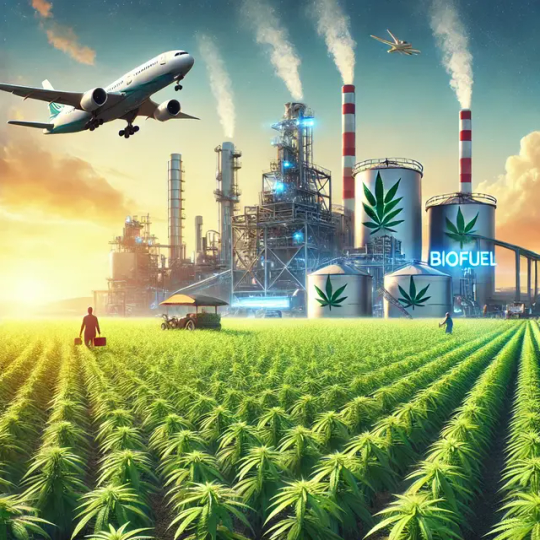
Introduction
The world stands at a critical crossroads, grappling with the dual challenges of increasing energy demands and climate change. With industries like aviation heavily reliant on fossil fuels, finding sustainable alternatives is no longer optional—it’s imperative. Amid this urgency, a surprising contender is emerging: cannabis, specifically industrial hemp, as a potential source of renewable jet fuel.
From its fast growth cycle to its ability to thrive in diverse conditions, hemp offers remarkable ecological and economic advantages. As researchers explore innovative ways to harness its energy potential, we may be on the cusp of a green revolution in aviation. Let’s delve into how cannabis could transform the skies, making jet fuel not just sustainable but revolutionary.
The Growing Need for Sustainable Energy in Aviation
The aviation industry accounts for nearly 2.5% of global carbon emissions. This might seem like a small percentage, but when you consider the cumulative environmental impact of millions of flights annually, the numbers become alarming. Traditional jet fuel, derived from fossil fuels, is one of the largest contributors to these emissions.
Efforts to transition to greener aviation fuels, such as biofuels from algae and waste materials, have shown promise. However, these alternatives often face scalability issues, high production costs, or supply limitations. A more sustainable and abundant resource is needed to meet the growing energy demands of global air travel. This is where hemp enters the picture, offering a renewable and viable solution to reduce the carbon footprint of aviation.
Cannabis: An Overview of Its Industrial Potential
Cannabis, often associated with recreational or medicinal use, is also a highly versatile crop with industrial applications. Hemp, a strain of cannabis with negligible psychoactive properties, has been cultivated for centuries for its fiber, seeds, and oil.
What makes hemp stand out is its adaptability and efficiency. It grows quickly, requires minimal water, and can thrive in a variety of climates. Its seeds are rich in oil, which can be processed into biodiesel, while its cellulose-rich stalks are ideal for ethanol production. These properties make hemp a promising candidate for the renewable energy sector, including aviation fuel.
Discover how Cannabis Waste to Jet Fuel is driving the next wave of sustainable energy for aviation.
How Cannabis Can Be Transformed into Jet Fuel
The process of converting hemp into biofuel involves several scientific steps, primarily focused on extracting usable energy components from the plant.
Oil Extraction: Hemp seeds are pressed to extract oil, which can be refined into biodiesel.
Cellulose Processing: The stalks are rich in cellulose, a key ingredient for ethanol and other biofuels.
Catalytic Refinement: Advanced technologies can further refine hemp oil and ethanol into aviation-grade fuel.
When compared to other biofuel sources like corn or soybeans, hemp offers higher yields and requires less intensive agricultural inputs. This makes it not only an environmentally friendly option but also a potentially cost-effective one.
Environmental Benefits of Hemp-Derived Jet Fuel
Hemp’s ability to combat climate change extends beyond its use as biofuel. Here’s how:
Carbon Sequestration: Hemp absorbs significant amounts of CO2 during its growth, effectively offsetting emissions from its fuel production and use.
Low Input Farming: It requires fewer pesticides and fertilizers compared to traditional crops, reducing the environmental impact of its cultivation.
Biodegradability: Any waste generated during hemp biofuel production is biodegradable, contributing to a circular economy.
The transition to hemp-based aviation fuel could lead to a substantial reduction in lifecycle greenhouse gas emissions, bringing us closer to carbon-neutral air travel.
Economic Opportunities from Cannabis-Based Aviation Fuel
The hemp-to-jet-fuel pathway isn’t just about sustainability—it’s a potential economic powerhouse. Hemp cultivation can create jobs, especially in rural and agricultural communities. Transitioning to hemp-based fuels provides farmers with a lucrative alternative to conventional crops, especially in regions facing agricultural challenges.
Additionally, scaling hemp biofuel production could drive down costs, making it competitive with traditional jet fuels. This economic potential makes hemp a win-win solution for the environment and the economy.
Overcoming Challenges in Adoption
While the potential of hemp-derived jet fuel is immense, realizing its full benefits requires addressing significant challenges:
Regulatory Hurdles: Many countries still have restrictive laws surrounding cannabis cultivation, even for industrial purposes. Easing these regulations is critical to enabling large-scale hemp farming and its use in energy production.
Technological Limitations: Developing cost-efficient and scalable methods to extract and refine hemp-based biofuels is a priority. Research in this area is ongoing but requires substantial investment.
Public Perception: Hemp often suffers from its association with marijuana, leading to public misunderstandings. Education and awareness campaigns can help demystify hemp’s role in sustainable energy.
Overcoming these obstacles demands coordinated efforts from policymakers, scientists, and industries. By fostering collaboration and innovation, the barriers to hemp-based aviation fuel adoption can be systematically dismantled.
Global Potential for Hemp Aviation Fuel
Hemp is an incredibly adaptable crop, capable of thriving in various climates, from temperate regions to semi-arid zones. This makes it a viable option for countries across the globe, including those with challenging agricultural conditions.
Developing Countries: Hemp cultivation can provide economic opportunities for developing nations, offering a sustainable crop with high market value.
Energy Independence: By producing their own biofuels, nations can reduce reliance on imported fossil fuels, bolstering energy security.
Global Supply Chain: Establishing international networks for hemp farming and biofuel production could transform the global energy landscape, making green aviation fuel accessible to all.
The global potential for hemp-based aviation fuel lies not just in its environmental benefits but also in its ability to create equitable economic opportunities.
Cannabis vs. Other Biofuel Sources
Hemp isn’t the only crop being considered for biofuel, but it has distinct advantages over many alternatives:CriteriaHempSoybeansAlgaeCornGrowth Cycle3-4 months4-5 monthsContinuous4-6 monthsWater RequirementsLowHighModerateHighLand Use EfficiencyHighModerateVery HighModerateEnvironmental ImpactPositive (CO2 sequestration)NeutralNeutralNegative (high pesticide use)Yield per Acre (Fuel)HighModerateHighLow
Hemp’s balance of high yield, low environmental impact, and versatility makes it a standout choice among biofuel crops, particularly for aviation.
The Role of Innovation in Expanding Hemp’s Potential
Innovation is the linchpin for maximizing hemp’s potential in the energy sector. Recent advancements in agricultural technology, such as precision farming and genetic improvements, have enhanced hemp yields and reduced production costs.
Farming Techniques: Modern irrigation methods and soil management practices can optimize hemp growth, even in challenging environments.
Biofuel Refinement: Emerging technologies in biofuel conversion, like enzymatic processing and catalytic cracking, are making hemp fuel production more efficient.
Integrated Systems: Hemp biofuel production can be coupled with other sustainable initiatives, like carbon capture technology and renewable power generation, to create a holistic green energy system.
By continuously pushing the boundaries of innovation, we can unlock even greater possibilities for hemp-derived energy solutions.
Cannabis and the Future of Green Aviation
Imagine a world where airplanes soar across the skies, powered by a fuel that’s not only renewable but also environmentally restorative. This vision isn’t as far-fetched as it seems. Hemp-based aviation fuel has the potential to:
Decarbonize Air Travel: By drastically reducing emissions, hemp biofuel could make aviation one of the greenest modes of transportation.
Inspire Industry Change: The adoption of sustainable fuels in aviation could set a precedent for other industries to follow.
Enhance Public Perception: Passengers and airlines alike would benefit from the positive environmental impact, creating a ripple effect of sustainability consciousness.
The future of aviation is undoubtedly tied to innovative energy solutions, and hemp is poised to play a starring role in this transformation.
Building a Hemp-Based Energy Ecosystem
To fully realize the potential of hemp-based aviation fuel, it’s essential to integrate it into a broader ecosystem of sustainability. This means:
Circular Economy Practices: Utilizing every part of the hemp plant ensures minimal waste and maximized utility. For example, while the seeds are used for oil, the stalks can be processed into materials like bioplastics.
Collaborative Efforts: Partnerships between energy companies, agricultural sectors, and governments are vital to creating a seamless supply chain.
Infrastructure Development: From farming facilities to biofuel refineries, building the necessary infrastructure is critical for scaling production.
This holistic approach not only amplifies the benefits of hemp fuel but also lays the groundwork for a more sustainable future across multiple industries.
Public Awareness and Policy Advocacy
For hemp aviation fuel to succeed, the public must be aware of its benefits, and policymakers must pave the way for its adoption. Key steps include:
Educational Campaigns: Informing the public about the environmental and economic advantages of hemp biofuel can help dispel misconceptions.
Policy Support: Governments need to incentivize hemp cultivation and biofuel production through subsidies, tax breaks, and research funding.
International Collaboration: Coordinated global efforts can accelerate the development and adoption of hemp-based fuels, ensuring widespread benefits.
Through awareness and advocacy, we can create the conditions necessary for hemp-derived jet fuel to take off—both literally and figuratively.
Conclusion
Hemp represents a beacon of hope in the quest for sustainable energy, particularly in the aviation sector. Its rapid growth, low environmental footprint, and high biofuel yield make it an unparalleled resource for addressing the twin challenges of climate change and energy demand.
By embracing cannabis-derived jet fuel, we can transform the skies into a cleaner, greener space, inspiring future generations to dream bigger and think sustainably. The journey from cannabis to jet fuel isn’t just about energy—it’s about redefining what’s possible in our fight for a better planet.
2 notes
·
View notes
Text
Apple Hills in Kitakami - How Realistic Is It?
I was playing pokemon violet and doing some shiny hunting in Kitakami, specifically in the Apple Hills, and while I was there it made me think. How realistic is the apple orchard compared to real life? I study horticulture and have taken a few classes on fruit and orchard production, so it sparked my curiosity.
(Just as a disclaimer, most of my knowledge of apple production comes from the United States rather than Japan, where Kitakami is based on. From what I read, most of the production is the same with a few minor differences. For example, most apple orchards in Japan are much smaller at a few acres while American apple orchards can be hundreds of acres. Also, I won’t claim to be an expert in apple production and if someone wants to correct me or add on feel free to. Most of this comes from my notes from different horticultural classes I have taken as well as university extension publications.)
Soils and Climate
Apples are temperate fruit crops but can grow within a wide range of latitudes depending on the variety grown, even subtropical areas if you manage it correctly. Kitikami is based on the Tohoku region of Japan, which is considered temperate. There is apple production in this area as well as Hokkaido and Nagano Prefecture.
In general, well drained and sloped land is preferable for temperate fruit crops like apples. Having the plant directly on top of a hill has better drainage and sunlight exposure, but is also exposed to more wind and weather that can damage the plant. Lowlands have issues with drainage and airflow, as cool air sinks and if it stays for a significant period of time it will cause freeze damage. The Apple Hills are located on a hill, true to their namesake, so this part is accurate.
Although irrigation isn’t a major factor in apple production as apples are fairly drought tolerant, it can be more convenient to locate an orchard near a water body. This is because larger water bodies help mitigate large temperature fluctuations and avoid spring freezes. I mention this because the Apple Hills are fairly close to a river, so it may or may not influence the production.
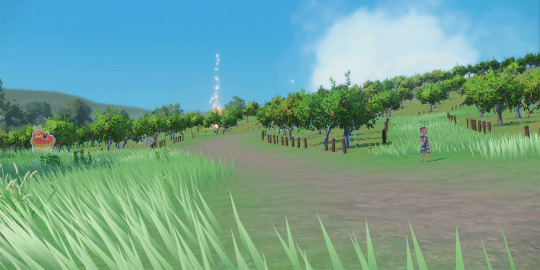
(From Bulbagarden)
Apple Tree Size and Structure
Different to popular belief, most apple trees in orchards are dwarfed. If left alone trees can get to 25 feet, but in some orchards they can be as small as 10 or even 8 feet tall. This dwarfing is done through a variety of techniques including using specific rootstocks, grafting, and training of the tree’s architecture. The trees within the Apple Hills are quite small, only reaching to about double the player’s height. Which isn’t that tall considering the player is still supposed to be a child, and that the average protagonist height is around 5 feet.
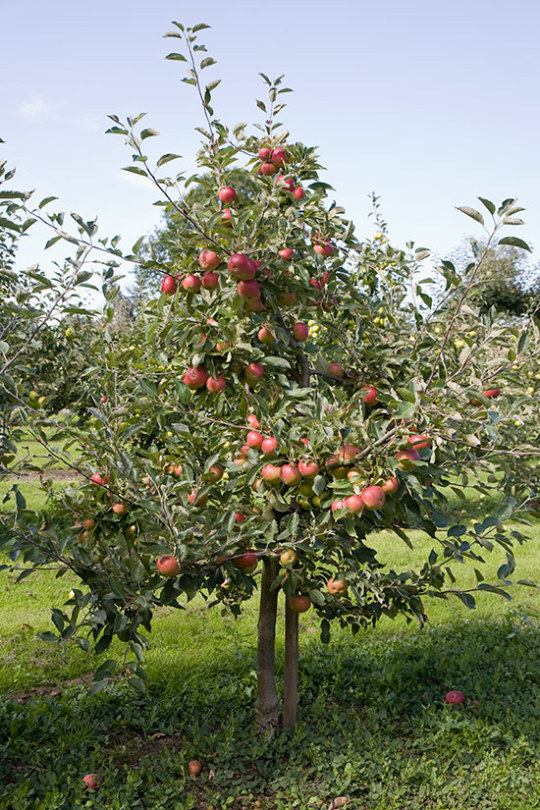
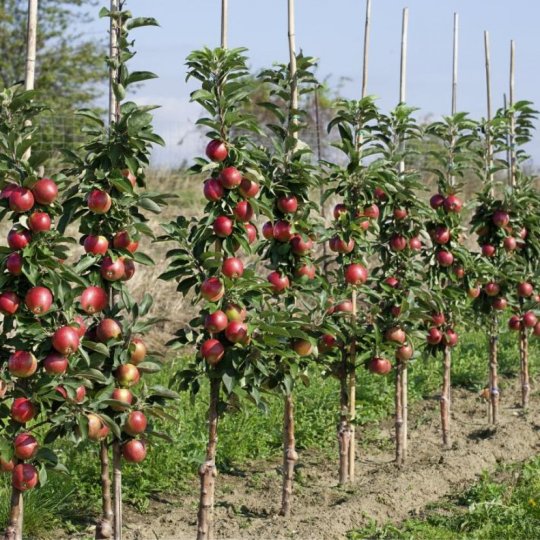
(Images from here and here)
The shape of apple trees can vary from orchard to orchard, but the two most common types are pyramidal with different tiers of branches or columnar. The pyramidal shape is usually done by training a central leader (or branch) to become the main branch and have the other horizontal branches become different tiers. This process makes for good light distribution into the canopy as well as restricting the growth somewhat. The columnar structure also helps with light distribution, but not as much as the pyramidal structure. However, the columnar structure helps with packing in more trees into an area and creates high density planting, which may increase total fruit yield. There is also a very thin structure called a spindle, which only has a canopy 1-2 feet in diameter and more cylindrical. They allow for easier harvesting and potentially more yield, but require support structures and more management The trees within the game have no one structure, some are wide and branched while others are more narrow. Although this isn’t accurate to real life, this is probably done for aesthetic purposes as to not make the orchard repetitive and boring for the player. The supports on the ground however are accurate as many trees are so small they need additional structures to help grow, otherwise the branches may snap off or the whole tree might fall over.
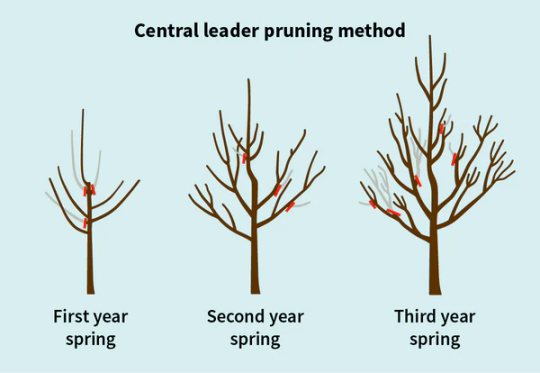
(Image from here)
Pokemon and Pests?
Some of the most prominent pests are codling moth, apple maggot, apple scab (fungal), and fire blight (bacterial). However, animals like birds and mammals can also be a problem. There are many different pokemon that spawn within the Apple Hills that may be considered pests, but I want to point out applin in particular. It’s based on ‘worms’ in apples (which in reality are the larvae or maggots of insects) and may be considered the biggest pest in the pokemon world. They eat and can disguise themselves as apples, potentially decreasing fruit quality and the total yield. But considering many trainers in Kitakami use applins in battle, it may also be a cultural icon that people love and will tolerate eating their apples. It may be true that a lot of the pokemon in the orchard will become pests, but considering the people of Kitakami live in harmony with pokemon and may find them cute, they could allow for some of the fruit to be eaten by pokemon while keeping the rest for themselves.

Taste of the Fruit
In a conversation in the League Club in the Blueberry Academy Amarys says in reference to the apples from Kitakami, “The high sugar content gives them a superb flavor”. In English the apples exclusive to Kitakami are called syrupy apples, while in Japan they are called honeycore apples. This is most likely in reference to honeycrisp apples, which are the most popular apple variety due to its crispy texture, sweetness, and juiciness. However, honeycrisp apples were bred for their taste rather than their ease of production. As such they are notorious for being hard to produce and require very specific conditions and maintenance in order for the tree to be productive enough to turn a profit. I don’t think this difficulty is the case within Kitakami since they grow so much and don’t have that much advanced equipment, but I would expect the taste to be similar to honeycrisp.


Sources:
4 notes
·
View notes